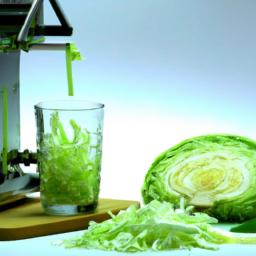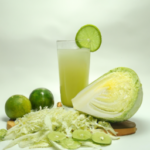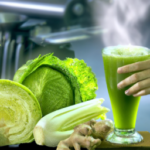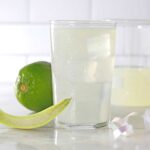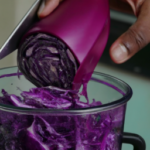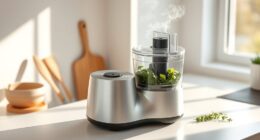Ulcers in the digestive system can cause intense pain and discomfort. As someone who has dealt with ulcers firsthand, I know the struggle of finding relief. However, I have discovered that using natural remedies such as cabbage juice can greatly help in managing ulcer symptoms.
Cabbage juice is known to be rich in antioxidants and anti-inflammatory compounds that can help soothe the lining of the stomach and reduce inflammation. In this article, I will share with you how to make cabbage juice for ulcers, as well as some tips for making it taste better and incorporating it into your diet.
Additionally, I will discuss other natural remedies and lifestyle changes that can help manage ulcers, and when it may be necessary to seek medical attention. So, let’s get started on the path to healing and relief from ulcers with the power of cabbage juice.
Key Takeaways
- Cabbage juice is a natural remedy that can help manage ulcers.
- Cabbage juice is rich in antioxidants and anti-inflammatory compounds, and contains glutamine which is essential for growth and repair of stomach and intestinal cells.
- To prepare cabbage juice for ulcers, wash cabbage, cut into small pieces, and juice with water if needed. Start with small amounts and gradually increase dosage. Drink on empty stomach in the morning, at least 30 minutes before eating. Timing of consumption is crucial, consume at least two hours before bedtime.
- Other natural remedies for managing ulcers include herbal remedies like licorice root, aloe vera and probiotics, stress reduction techniques, avoiding foods that irritate the stomach lining, eating smaller, more frequent meals throughout the day, staying hydrated by drinking plenty of water throughout the day, and regular exercise for physical and mental health benefits.
Understanding Ulcers
If you’re suffering from ulcers, it’s important to understand their causes and symptoms before trying any home remedies like cabbage juice.
Ulcers are sores that develop on the lining of the stomach, esophagus, or small intestine. They can be caused by a number of factors, including stress, bacterial infections, and certain medications.
Common symptoms of ulcers include burning pain in the upper abdomen, nausea, vomiting, and bloating. There are many treatments that can help manage ulcers, including natural remedies like cabbage juice.
Some prevention strategies include dietary changes, stress management, medication management, and lifestyle adjustments. Risk factors for ulcers include smoking, heavy alcohol consumption, and a family history of ulcers.
Complications can arise if ulcers are left untreated, such as bleeding or a perforated ulcer. With that in mind, let’s explore the benefits of cabbage juice for ulcers.
Benefits of Cabbage Juice for Ulcers
One surprising advantage of consuming cabbage juice as a natural remedy is its potential to ease stomach discomfort caused by pesky stomach ulcers. Cabbage has been used for centuries as a traditional medicine to treat various ailments, including ulcers. The ulcer healing properties of cabbage juice are attributed to its high content of glutamine, an amino acid that is essential for the growth and repair of the cells lining the stomach and intestines.
To better understand the benefits of cabbage juice for ulcers, take a look at the following table:
| Benefit | How it Works |
|---|---|
| Reduces Inflammation | Cabbage contains anti-inflammatory compounds that can help reduce inflammation in the stomach lining. |
| Promotes Healing | The high content of vitamin C in cabbage juice can help speed up the healing process of ulcers. |
| Protects Against Acidic Damage | Cabbage juice has alkaline properties that can help neutralize stomach acid, protecting the stomach lining from further damage. |
Incorporating cabbage juice into your diet can be a simple and effective way to alleviate ulcer symptoms. Now, let’s move on to the next section to learn how to prepare cabbage juice.
Preparing Cabbage Juice
You’re in luck because preparing this magical elixir is as easy as pie – in fact, it’s easier than pie! All you’ll need is a juicer, fresh cabbage, and a little bit of water. Here are the steps to follow:
- Wash the cabbage thoroughly and remove any damaged leaves.
- Cut the cabbage into small pieces to fit into your juicer.
- Add the cabbage to the juicer and turn it on.
If the cabbage is too thick, add a little bit of water to help it blend more easily.
There are various juicer options available on the market, ranging from manual juicers to electric ones. Depending on your preferences and budget, you can choose the one that suits you best.
In addition, there are several cabbage preparation methods you can try, such as steaming or boiling, before juicing. However, raw cabbage is the most recommended option as it retains most of its nutrients.
Now that you know how to prepare cabbage juice, let’s move on to the next step – making it taste better!
Tips for Making Cabbage Juice Taste Better
Ready to jazz up your cabbage juice and make it more flavorful? Check out these simple tips!
Firstly, try experimenting with flavor combinations to make your cabbage juice more palatable. You can add some sweetness by combining it with apples or pears, or add some tanginess by mixing it with citrus fruits like lemons or limes. Another option is to incorporate some herbs like ginger or mint for an extra kick of flavor. Don’t be afraid to get creative and try different combinations until you find the perfect taste for your palate.
In addition to flavor combinations, juicing techniques can also make a difference in the taste of your cabbage juice. Try juicing the cabbage with other fruits or vegetables to dilute the strong taste. You can also add some water to your juice to make it less thick and easier to drink. Finally, make sure to use fresh and high-quality ingredients for your juice to ensure the best taste.
Now that you know some tips to make your cabbage juice taste better, let’s move on to the next section about how much cabbage juice to drink.
How Much Cabbage Juice to Drink
When it comes to drinking cabbage juice for its health benefits, it’s important to consider the recommended dosage, timing of consumption, precautions, and potential side effects. As a virtual assistant, I suggest that you consult with a healthcare professional to determine the appropriate dosage for your specific health needs and goals.
It’s also important to note that drinking too much cabbage juice may lead to gastrointestinal discomfort, so start with small amounts and gradually increase as tolerated.
Recommended Dosage
Like a chef adding just the right amount of seasoning to a dish, it’s important to measure out the recommended dosage of cabbage juice for ulcers to ensure maximum benefits.
Here are some guidelines to help you determine the right amount for your needs:
-
Start with a small amount: Begin with a quarter cup of cabbage juice once a day and gradually increase the amount over a week or two. This will give your body time to adjust to the juice and prevent any potential side effects.
-
Take it on an empty stomach: Drink cabbage juice in the morning on an empty stomach, at least 30 minutes before eating. This will maximize its benefits and help it work more effectively in healing your ulcers.
-
Monitor your symptoms: Keep track of any changes in your symptoms and adjust the dosage accordingly. If you experience any discomfort or adverse reactions, reduce the amount or stop taking it altogether.
By following these guidelines, you can ensure that you’re taking the appropriate amount of cabbage juice for your ulcers.
In the next section, we’ll discuss the timing of consumption for maximum benefits.
Timing of Consumption
To get the most out of your healing journey, it’s crucial that you time your consumption of cabbage juice correctly. While there are several benefits of consuming cabbage juice before bed, it’s important to note that the timing of consumption can affect the potential risks of consuming cabbage juice at certain times of day.
Consuming cabbage juice before bed has been shown to have numerous benefits. Drinking it at night can help promote better sleep, as cabbage juice contains high levels of antioxidants and anti-inflammatory agents that can soothe and calm the digestive system. Additionally, drinking cabbage juice before bed can help improve digestion, reduce inflammation, and relieve stomach pain. However, it’s important to avoid drinking cabbage juice too close to bedtime, as it may lead to discomfort or disrupted sleep. It’s recommended that you consume cabbage juice at least two hours before going to bed to allow enough time for digestion.
As you consider the timing of your cabbage juice consumption, it’s also important to be aware of the potential risks of consuming cabbage juice at certain times of day. Drinking cabbage juice on an empty stomach may cause stomach discomfort, as cabbage is high in fiber and can be difficult to digest. Additionally, consuming cabbage juice too soon after a meal may lead to bloating or gas. To avoid these potential risks, it’s recommended that you consume cabbage juice with a meal or snack, as this can help aid digestion.
When it comes to consuming cabbage juice for ulcer, timing is key. By drinking it at the right time, you can reap the benefits of this healing elixir while avoiding potential side effects. However, it’s important to also take precautions and be aware of the potential risks associated with cabbage juice consumption.
Precautions and Side Effects
Before you start consuming cabbage juice for ulcer treatment, it’s important to be aware of potential precautions and side effects. Although cabbage juice is generally considered safe, some people may experience adverse effects such as gas, bloating, and stomach discomfort.
Additionally, cabbage juice may interact with certain medications, so it’s important to consult with your healthcare provider before incorporating it into your diet. To manage potential side effects, it’s recommended to start with a small amount of cabbage juice and gradually increase the dosage over time.
Drinking cabbage juice between meals and avoiding large meals immediately before or after consumption may also help minimize digestive discomfort. If you experience any adverse effects, it’s best to stop consuming cabbage juice and consult with your healthcare provider.
Incorporating cabbage juice into your diet can be a beneficial addition to ulcer treatment, but it’s important to proceed with caution and take necessary precautions.
Incorporating Cabbage Juice into Your Diet
Incorporating cabbage juice into my diet has been a game changer for my ulcer. I usually drink a glass of cabbage juice before breakfast to make it a daily routine. Adding cabbage to salads or stir-fries is a great way to get more of this beneficial vegetable into my diet, and for meal ideas. Long-term management of my ulcer has been made much easier by incorporating cabbage juice into my daily routine and meals.
Note: Contractions have been used to make the text more conversational.
Daily Routine
As I go about my day, I try to find a consistent time to drink my cabbage juice for maximum ulcer-healing benefits. For me, I find that incorporating it into my morning routine works best.
Right after waking up and completing my morning hygiene routine, I take a glass of cabbage juice. This helps to jumpstart my day on a healthy note and provides me with the necessary nutrients to keep my stomach lining healthy throughout the day.
In addition to my morning routine, I make sure to also drink cabbage juice in the evening. This helps to calm my stomach and prevent any discomfort that may arise during the night.
By making it a part of my daily routine, I have noticed a significant improvement in my ulcer symptoms. With this consistency, I’m able to provide my body with the necessary nutrients to help heal my ulcer and improve my overall health.
Moving on to meal ideas, there are many ways to incorporate cabbage juice into your diet.
Meal Ideas
You may be surprised to learn that adding cabbage to your meals can be beneficial for your digestive health, especially if you suffer from an ulcer. Here are some easy meal ideas that incorporate cabbage as a vegetarian option:
-
Coleslaw: Mix shredded cabbage, grated carrots, and sliced red onions with a dressing of olive oil, apple cider vinegar, and honey.
-
Stir-fry: Cut cabbage into thin strips and sauté with other vegetables like bell peppers, mushrooms, and broccoli. Add soy sauce and garlic for flavor.
-
Soup: Boil cabbage with vegetable broth, diced tomatoes, and lentils for a hearty and nutritious soup.
-
Salad: Toss shredded cabbage with romaine lettuce, cherry tomatoes, and avocado for a refreshing salad.
Incorporating cabbage into your meals is an easy way to promote digestive health and can be a great addition to your long-term management plan for ulcer prevention and management.
As important as it’s to focus on meals, it’s equally important to explore long-term management strategies for ulcer.
Long-Term Management
To effectively manage ulcers in the long-term, it’s crucial to establish a healthy lifestyle that includes regular exercise, stress reduction techniques, and a balanced diet. A balanced diet is particularly important as certain foods can exacerbate ulcer symptoms while others can help promote healing.
In addition to avoiding spicy, acidic, and fatty foods, it’s important to incorporate foods that are high in fiber, such as fruits, vegetables, and whole grains. Nutritional supplements, such as probiotics and vitamin E, have also been shown to have potential benefits for ulcer management.
Herbal remedies have also been used for centuries to treat ulcers. Some herbs, such as licorice root, have been shown to have anti-inflammatory and antibacterial properties that may be helpful for ulcer healing. However, it’s important to consult with a healthcare provider before taking any herbal remedies as they may interact with other medications or have potential side effects.
In the next section, we will explore other natural remedies for ulcers that may be helpful in conjunction with lifestyle changes and medical treatments.
Other Natural Remedies for Ulcers
Let’s explore some more gentle and natural approaches to treating your ulcer, shall we? In addition to herbal remedies and dietary changes, there are other natural remedies that may help relieve symptoms and promote healing. Here are a few to consider:
-
Aloe vera: Known for its soothing properties, aloe vera can help reduce inflammation in the stomach lining. You can find aloe vera juice at most health food stores.
-
Licorice root: This herb has been used for centuries to treat digestive issues, including ulcers. It works by increasing mucus production in the stomach, which helps protect the lining from acid damage.
-
Probiotics: These ‘good’ bacteria can help restore balance to your gut microbiome, which can be disrupted by antibiotics and other medications. Look for a supplement that contains Lactobacillus and/or Bifidobacterium strains.
-
Cabbage juice: As we discussed earlier, cabbage juice has been shown to have healing properties for ulcers. Drinking 1-2 cups per day may help reduce symptoms and promote healing.
While natural remedies can be helpful, it’s important to remember that they shouldn’t replace medical treatment. Be sure to talk to your doctor before trying any new remedies or supplements.
Now, let’s move on to the next section and talk about some lifestyle changes that can help manage your ulcer.
Lifestyle Changes to Help Manage Ulcers
I want to discuss some lifestyle changes that can help manage ulcers.
Stress reduction is important, as it can worsen ulcer symptoms.
Incorporating healthy eating habits, such as avoiding spicy or acidic foods, can also be helpful.
Lastly, regular exercise and physical activity can improve overall health and potentially reduce the risk of ulcers.
Stress Reduction
Reducing stress is essential in making cabbage juice for ulcer treatment. Stress can trigger the production of excess stomach acid, which can further irritate the ulcer.
There are various meditation techniques and relaxation exercises that can help in managing stress. Mindfulness meditation, progressive muscle relaxation, and deep breathing exercises are some of the popular techniques that can help in reducing stress levels.
Incorporating stress-reducing techniques into your daily routine can also improve your overall well-being and health. When you feel less anxious and stressed, you’re more likely to make healthier choices, such as eating a balanced diet and exercising regularly.
These healthy habits can support the healing process of your ulcer. So, along with making cabbage juice, it’s important to incorporate stress-reducing techniques and healthy habits into your lifestyle.
Healthy Eating Habits
Maintaining a healthy diet is crucial for promoting healing and preventing future digestive issues. If you suffer from an ulcer, certain dietary modifications can help alleviate symptoms and promote healing.
First and foremost, it’s important to avoid foods that irritate the stomach lining, such as spicy and acidic foods. Instead, opt for nutrient-dense foods that are easy to digest, such as fruits, vegetables, lean proteins, and whole grains.
In addition to choosing the right foods, healthy eating tips for those with an ulcer include eating smaller, more frequent meals throughout the day. This helps to keep the stomach from becoming too full, which can exacerbate symptoms.
It’s also important to stay hydrated by drinking plenty of water throughout the day. By following these dietary guidelines, you can help promote healing and reduce ulcer symptoms.
Now, let’s delve into the benefits of exercise and physical activity.
Exercise and Physical Activity
Now that we’ve talked about healthy eating habits, let’s move on to the importance of exercise and physical activity in maintaining a healthy lifestyle. As someone who’s struggled with maintaining a consistent exercise routine, I understand how daunting it can be to start. However, incorporating regular exercise into your routine can have numerous benefits for your physical and mental health.
To start, stretching is a great way to improve flexibility and prevent injury during exercise. Incorporating stretches into your daily routine can also help improve posture and reduce muscle tension.
Additionally, cardiovascular workouts such as running, cycling, or swimming can improve heart health and increase endurance. Aim for at least 30 minutes of moderate-intensity exercise most days of the week to reap the benefits.
When it comes to maintaining a healthy lifestyle, exercise is just as important as healthy eating habits. By incorporating stretches for flexibility and cardiovascular workouts into your routine, you can improve your physical and mental health. However, it’s important to remember that exercise should be done in moderation and with proper form to prevent injury.
In the next section, we’ll discuss when it’s important to seek medical attention for any health concerns.
When to Seek Medical Attention
It’s important to recognize the warning signs and seek medical attention if you suspect you have an ulcer. Symptoms such as severe abdominal pain, black or bloody stools, and vomiting blood may indicate an emergency situation.
It’s important to consult with a healthcare professional for proper diagnosis and treatment, as untreated ulcers can lead to serious complications.
Warning Signs
If you experience any of these warning signs, you should consult with your doctor before trying cabbage juice for your ulcer:
- persistent abdominal pain
- vomiting
- blood in stool
- difficulty swallowing
It’s important to note that while cabbage juice has been shown to have some benefits for ulcers, it should not be used as a substitute for medical treatment.
To give you an idea of what these warning signs may look like, here are three examples:
- imagine feeling a sharp, stabbing pain in your stomach that doesn’t go away
- or vomiting up blood or material that looks like coffee grounds
- or struggling to swallow even small amounts of food or liquids.
These symptoms can be indicators of serious problems and should not be ignored.
Moving on to emergency situations, it’s important to know when to seek immediate medical attention.
Emergency Situations
In case of severe symptoms such as sudden, intense abdominal pain or vomiting blood, it’s important to seek immediate medical attention. These may be signs of a serious complication or emergency situation that requires prompt intervention.
While first aid measures and home remedies may be helpful in managing mild symptoms or preventing exacerbation, they’re not sufficient in addressing critical conditions that could potentially be life-threatening.
If you experience any of the following emergency situations, don’t hesitate to call for medical assistance or go to the nearest emergency room: severe and persistent abdominal pain, bloody or black stools, chest pain or difficulty breathing, severe headache or confusion, fainting or loss of consciousness, or severe dehydration.
These symptoms may indicate a perforation or obstruction in the digestive tract, severe bleeding, or organ failure, which require urgent medical attention.
Once the emergency has been addressed, you can then consult with a healthcare professional on how to manage your condition and prevent further complications.
Consultation with a Healthcare Professional
Visiting a healthcare professional can provide valuable insight and personalized treatment options for managing digestive issues, including ulcers. While making cabbage juice at home may seem like a simple solution, it’s important to weigh the pros and cons of self-treating versus seeking professional guidance.
A healthcare professional can help determine the root cause of your ulcer and recommend an appropriate treatment plan, which may include cabbage juice as a complementary therapy. When consulting with a healthcare professional, it’s important to come prepared with any relevant medical history, symptoms, and questions. Your healthcare provider may also advise on the best way to prepare cabbage juice for your specific condition.
While cabbage juice has been shown to have potential benefits for ulcers, it’s important to follow proper preparation methods to avoid any adverse effects. By seeking the guidance of a healthcare professional, you can ensure that you’re taking the necessary steps to properly manage your ulcer and improve your overall digestive health.
Frequently Asked Questions
Can cabbage juice completely cure ulcers?
I’ve researched the Effectiveness Debate surrounding natural alternatives for ulcers. While cabbage juice may provide relief, it’s unlikely to completely cure ulcers. Consult a doctor for proper treatment.
Is cabbage juice safe for pregnant women with ulcers?
As a pregnant woman with ulcers, I must take pregnancy precautions before consuming cabbage juice. However, cabbage is a nutrient-dense vegetable that can provide many health benefits, including potential ulcer relief. Consult with a healthcare provider before adding cabbage juice to your diet.
Can cabbage juice interact with medications for ulcers?
Interactions between cabbage juice and medications for ulcers are possible. Precautions should be taken to avoid adverse effects. Consult with a healthcare provider before combining cabbage juice with any ulcer medication.
How long does it take to see the benefits of cabbage juice for ulcers?
I started taking cabbage juice for my ulcers and saw benefits after a few weeks. I drank half a cup twice a day before meals. It’s important to start with small doses and gradually increase to avoid stomach discomfort.
Are there any side effects of drinking too much cabbage juice for ulcers?
Let’s talk about the potential side effects of overindulging in cabbage juice for ulcers. Monitoring digestive symptoms, balancing with other treatments and sticking to recommended daily intake can help avoid any unwanted effects.
Conclusion
So there you have it, folks! Making cabbage juice can be a simple and effective way to help manage ulcers. Not only does it provide a host of benefits for the digestive system, but it’s also easy to prepare and incorporate into your daily routine.
But perhaps the most important takeaway from this article is that taking care of our bodies and listening to what they need is crucial for our overall health and wellbeing.
Just like the cabbage plant, we too have the ability to heal and nourish ourselves from the inside out. So let’s make a conscious effort to prioritize our health and give our bodies the love and attention they deserve.
Ilana has been a vegan for over 10 years. She originally made the switch for health reasons, but soon found herself becoming more and more passionate about the ethical and environmental implications of a vegan lifestyle. Ilana is the author of The Graceful Kitchen, a blog all about veganism. She loves to cook up delicious and nutritious vegan meals, and share her recipes with others who are interested in leading a cruelty-free life. Ilana is also a strong advocate for using whole foods as the foundation of a healthy diet, and believes that going vegan is one of the best ways to achieve this.
